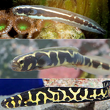Pholidichthys leucotaenia 5-6 cm
- Manufacturer: JadwigaMorska
-
Availability:
 None
(0 pcs.)
None
(0 pcs.)
- pcs.
- €22.57
Pholidichthys leucotaenia, also known as the White-banded triggerfish, is a species of fish from the Balistidae family. Here is a general description of this species and information about its cultivation:
Description of Pholidichthys leucotaenia:
- Appearance: Pholidichthys leucotaenia has a distinctive appearance with white and black bands running along its body, hence its English name "White-banded triggerfish." It is an oval-shaped fish, and its dorsal fin is tucked into a small edge. It is a marine species with an attractive appearance.
- Size: Individuals of this species can reach a body length ranging from 20 to 30 centimeters.
- Behavior: Pholidichthys leucotaenia is a calm and typically territorial fish. It is a benthic fish, meaning it likes to gather at the bottom of the ocean or aquarium in search of food. It can exhibit aggressive behavior towards other fish, so it's important to carefully choose its tankmates.
Cultivation of Pholidichthys leucotaenia fish in marine aquariums:
- Aquarium: An aquarium intended for the cultivation of Pholidichthys leucotaenia should be appropriately adapted to this species. This fish requires plenty of swimming space, as well as hiding spots and shelters where it can hide. It's also advisable to provide proper lighting to enhance its beautiful colors.
- Water Parameters: Maintaining stable water parameters is crucial. The aquarium water should have a temperature ranging from 24-28°C (75-82°F) and the appropriate salinity level, usually between 1.023 and 1.025. Good water filtration and regular water changes are important.
- Feeding: Pholidichthys leucotaenia is a predatory fish that primarily feeds on marine invertebrates such as small crustaceans, mollusks, and other benthic organisms. In the aquarium, they can be fed with frozen foods like shrimp, mysid shrimp, brine shrimp, as well as suitable food for marine fish.
Cultivating Pholidichthys leucotaenia fish in marine aquariums can provide fascinating views due to its distinctive appearance. However, due to its territorial and aggressive behavior towards other fish, it's important to carefully plan the tank's composition and monitor the fish's behavior.



